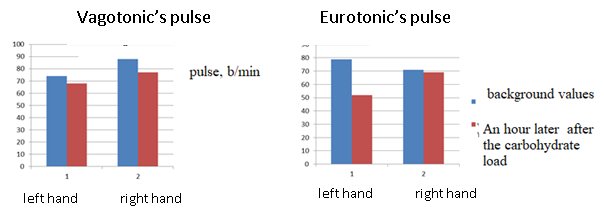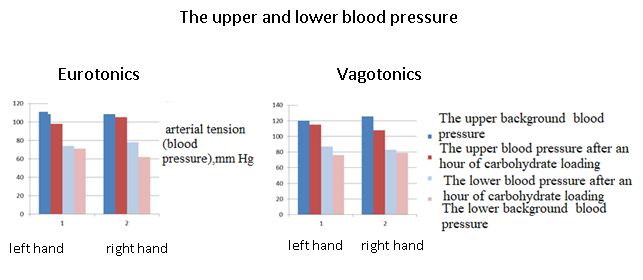To characterize the functional state of the autonomic nervous system (ANS) or otherwise (symptovagus balance), several parameters are used, one of which is the vegetation index (VI). This indicator characterizes the balance of ergotropic mechanisms (associated with adrenoreceptors of unstriated muscles of organs) and trophotropic (the work of muscarinic receptors in the lining of internal organs) controlling influences. On the basis of this parameter, all research subjects were divided into three groups: eurotonics — (0.8 ≤ VI ≤ 1 RU), vagotonics — (VI ≤ 0.7 RU) and sympathotonics — (VI ≥ 1.1 RU) [1 — 5]. The research subjects — vagotonics have a parasympathetic type of ANS, and eurotonics or sympathotonics — a sympathetic type of ANS.
The glucose tolerance test (GTT) is a laboratory test used to diagnose impaired glucose tolerance (prediabetes) and diabetes mellitus.The «pain» method of express diagnostics was used to study the level of glycemia before and after glucose loading. Test subjects experience pain when using a needle to test blood sugar level.
Purpose of study.
The article is concerned with the changes in the parameters associated with the sympatho-vagal balance before and after the carbohydrate loading, depending on the type of the subject’s autonomic system.
Research methods.
The study involved 11 female student volunteers aged 18-22 years old, conditionally healthy, without signs of cardiovascular and respiratory pathology. The data of the two-group research subjects were selected for analysis: vagotonics — 45% (VI≤0.5 RU; n = 5 people) and sympathotonics (eurotonics) — 55% (VI ≥1 RU; n = 6 people). To determine the vegetative index, the Neuron-spectrum-1 electroencephalograph was used with a specialized package of applied programs for spectral analysis of the rhythmic activity of the human brain [1,2,4 — 6] in the frequency spectrum from 0.1 to 30 Hz. The measurements were carried out in the Laboratory of Ecological Neurocybernetics of RDE «Arktika» FEB RAS.
Procedure.
For each research subject with their eyes closed, data were taken during at least six frames: 3 readouts of the evoked cerebral bioelectrical activity (to determine VI) immediately after assessing blood sugar level on an empty stomach and 3 readouts an hour after eating a carbohydrate loading. OneTouch Select Simple glucometer is used. The device is supplied with a set of OneTouch Select test strips (10 pieces), lancets and a special handle for comfortable finger piercing (pain stimulus).
Particularly at this moment the test subject experiences pain, which causes a bioelectrical response. Integration time of each capture (frame duration) 160 sec. There were no breaks between sessions.
Thus, the vegetation index was being determined for a total of 480 seconds in the background mode and the same amount an hour after the carbohydrate loading.
The blood sugar level was determined 2 times: in the background mode, i.e. immediately on an empty stomach and the second time an hour after consuming a standard carbohydrate loading. The standard carbohydrate load includes 75 grams of anhydrous glucose (standard package) diluted in 250-300 ml of warm (37-40 C) drinking water, which is drunk within 2-5 minutes.
Results and discussion
Vegetation index. Diagrams of the vegetation index, specifically attributed to each group, measured before and after the glucose tolerance test for research subjects with different types of ANS, are shown in Fig. 1.
According to the results (Fig. 1a), of sympathotonics, an hour after the carbohydrate loading, the vegetation index falls. In the tested vagotonics, the vegetation index increases (Fig. 1b).
- a) test subject sympathotonic (eurotonic) b) test subject vagotonic

Fig.1. Vegetation index: research subject with closed eyes — the first 3 bars in the background mode, the last three bars one hour after the carbohydrate loading.
Blood sugar level. The measurement data are presented in Table 1. Among the test subjects- sympathotonics, the blood sugar level decreases by an average of 0.43 mmol/L, and among the tested vagotonics it increases by an average of 0.8 mmol/L.
Table 1
Blood sugar level of test subjects in the background mode and an hour after
a carbohydrate loading.
| sympathotonics | vagotonics | ||||||
| Test subject | Blood sugar level
(mmol/L)
|
BSL after carbohydrate load
(mmol/L)
|
difference | Test subject | Blood sugar level (mmol/L)
|
BSL after carbohydrate load
(mmol/L)
|
difference |
| 1. | 5,7 | 4,9 | -0,8 | 1. | 5,3 | 6,1 | 0,8 |
| 2. | 6,3 | 6,2 | -0,1 | 2. | 4,6 | 6 | 1,4 |
| 3. | 5,8 | 5,3 | -0,5 | 3. | 4,7 | 4,9 | 0,2 |
| 4. | 5,6 | 5,3 | -0,3 | ||||
| average | 5,85 | 5,43 | -0,43 | 4,87 | 5,67 | 0,8 | |
The obtained data on the level of sugar are consistent with the results of the vegetation index: test subjects with a parasympathetic type of ANS, energy in the form of carbohydrates is accumulated, and VI slightly increases. And the sympathetic branch of the ANS is focused on using energy, so the sugar level drops and the vegetation index decreases.
Dynamics of pulse and blood pressure on the left and right hand before and after (in an hour) the carbohydrate loading.

Fig.2. The pulse on the left and right hand in the background mode and one hour after the carbohydrate loading among the test subjects — eurotonics (sympathotonics) and vagotonics
In groups of test subjects of sympathotonics (eurotonics), the pulse (Fig. 2), and blood pressure (Fig. 3) on both hands decrease: an hour after the use of carbohydrate loading, all received lower figures different from the background ones.
Among the test subjects — vagotonics, the effect of lowering the pulse on the left hand was more pronounced (Fig. 2b) than among eurotonics.
The decrease in blood pressure (Fig. 3b) in the test subjects — vagotonics is most pronounced on the right hand for the upper level of blood pressure, i.e. at the moment of maximum contraction of the heart.

Fig.3. Blood pressure (upper and lower) on the left and right hand in the background mode and one hour after the carbohydrate loading among the test subjects — eurotonics (sympathotonics) and vagotonics.
Summary
- The data obtained confirm the trophotropism of the parasympathetic branch of the autonomic nervous system. The shift in the sympatho-vagal balance towards a thrifty attitude to energy of the test subjects — vagotonics is indicated by an increase in blood sugar level an hour after a carbohydrate loading.
- The process of active absorption of sugar follows from the decrease in blood sugar level of eurotonics, test subjects with ANS of the sympathetic type.
- A change in the vegetation index responds to a change in the blood sugar level of the test subjects: among eurotonics, VI decreases, among vagotonics, VI increases.
- Pulse and blood pressure (BP), upper and lower, tend to decrease in both eurotonics and vagotonics. The most evident decrease in the pulse after a carbohydrate loading among vagotonics on the left hand (the pulse becomes less frequent). A significant decrease in upper blood pressure among vagotonics after a carbohydrate loading was on the right hand.
- Among eurotonics, the change in heart rate and blood pressure after the carbohydrate loading is less profound than among vagotonics.
References
1. Klochkova O. Belonozhko O., Garanina I., Horol'skaya I., Shabanov G Changes in the spectrum of evoked oscillations of the bioelectric function of subject after the eating of lemon// Book of Abstracts: XVI European Congress of Psychology (ECP 2019) (2 ‒ 5 July, 2019, Lomonosov Moscow State University, Moscow). — Moscow: Moscow University Press, 2019. — p.15642. Klochkova O.I., Shabanov G.A. Session dynamics of changes in the bioelectrical activity of the brain during the intellectual work at the computer//National Psychological Journal No. 1(37) 2020.-p. 78-93
3. Baevsky R.M. Classification of health levels from the point of view of the theory of adaptation // Bulletin RAMS USSR - 1989. –No. 8. -p.73-78.
4. Baevsky R.M., Berseneva A.P. Assessment of the adaptive capacity of the body and the risk of disease progress. - M.: Medicine, 1997. - 236 p.
5. Utility patent No. 72395. Application No.2007145888. Priority dated December 3, 2007. Magnetoencephalographic spectrum analyzer, adder of human brain biopotentials. Authors: Lebedev Yu.A., Shabanov G.A., Rybchenko A.A., Maksimov A.L. GU RF MRC "ARCTICA" FEB RAS, director Maksimov A.L. Published: 20.04.2008 Bull. №11
6. Shabanov G.A., Maksimov A.L., Rybchenko A.A. Functional-topical diagnosis of the human body based on the analysis of the rhythmic activity of the brain. - Vladivostok: Dalnauka, 2011. – p.206
